Matador Network's Blog, page 494
April 15, 2022
You Can Customize Your Favorite YETI Travel Mug for Free This Week

YETI, a brand well known for its durable coolers as well as for keeping your hot drinks hot and your cold drinks cold for anywhere from hours to days, is stepping up the game with customizable mugs this spring. The trendy bottles, tumblers, wine glasses, can cozy, and pet bowls will make the perfect gift for the special mom in your life. And to celebrate, YETI is offering free text and monogram customization on its Rambler line of bottles, coozies, and tumblers, and even its 8 oz. Boomer dog bowl.
We hope you’re as excited about the YETI Mother’s Day sale as we are! Just so you know, Matador may collect a small commission from the links on this page if you decide to book a stay. Listed prices are accurate as of the time of publication.
There’s a lot to choose from. Here are some of the most popular options (non-customized — what will yours say?), with photos below:
36 oz. bottle,20 oz. bottle20 oz. tumbler12 oz. can coozie12 oz. bottle10 oz. wine tumbler10 oz tumbler
Photo: REI

Photo: REI
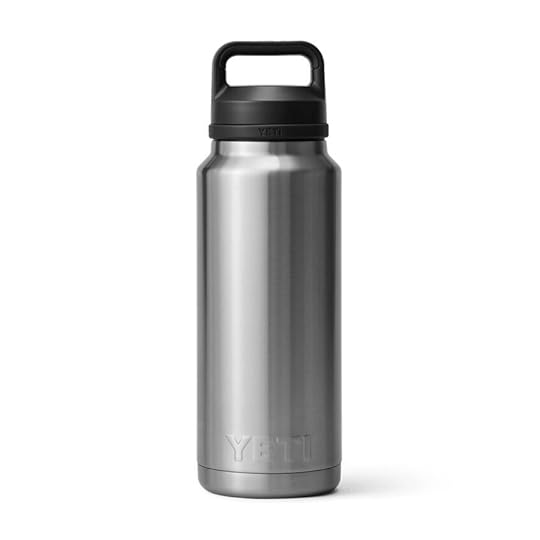
Photo: REI

Photo: REI
The YETI Mother’s Day Sale has something for all active momsChoose from any of the products in the available line and pick your favorite color — the deal includes seasonal colors like Bimini Pink and Offshore Blue. Then add your text or monogram in the customization section, and YETI will cover the cost. The deal does not include limited-edition Mother’s Day designs, user uploaded graphics, or licensed designs. And keep it clean! YETI will cancel any licensed, copyrighted, profane, or political orders.
This promotion only runs through April 19, so you’ll want to be quick! It can take up to two weeks for processing, so you’ll want to get your order in as soon as possible to make sure it arrives in time for Mother’s Day. The orders will not include gift messages, so you’ll want enough time to wrap your present and get the perfect card to go with it.
So go ahead and get mom her personalized YETI, and with this promotion, it’s worth getting one for yourself while you’re at it. 
Check Into Relaxation at These Boutique Puerto Vallarta Airbnbs

Adventure pursuits, watersports, nightlife, and – of course – tacos aplenty make Puerto Vallarta one of Mexico’s top vacation spots. This laid-back resort in Jalisco state is known for its high safety rating and LGBTQ-friendly ethos. Here are the top-rated (and genuinely unforgettable) Puerto Vallarta Airbnb rentals for families, couples, and groups.
Puerto Vallarta vacation rentals with chef serviceBest Puerto Vallarta Airbnbs for HoneymoonersBest all-inclusive Puerto Vallarta bed and breakfastCoolest Puerto Vallarta AirbnbsWe hope you love the Puerto Vallarta Airbnb stays we recommend! Just so you know, Matador may collect a small commission from the links on this page if you decide to book a stay. Listed prices are accurate as of the time of publication.
Puerto Vallarta vacation rentals with chef serviceThe Green House – super private villa in marina for groups
Photo: Airbnb

Photo: Airbnb
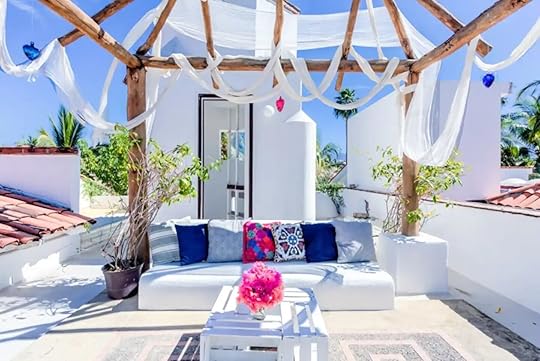
Photo: Airbnb

Photo: Airbnb
You’ll soon figure out what earned this Airbnb near the Puerto Vallarta Marina its name. The Green House villa and garden complex is abundant with lush plants, flowers, and palm trees that are best enjoyed from the large open-air swimming pool. Take your pick from yoga classes in the garden, stargazing on the rooftop terrace, and late-night cocktail parties in the pergola. No need to make a dinner reservation in town; your home chef is only a phone call away.
Sixteen guests, eight bedrooms
Price: $1,240 per night

Photo: Airbnb

Photo: Airbnb
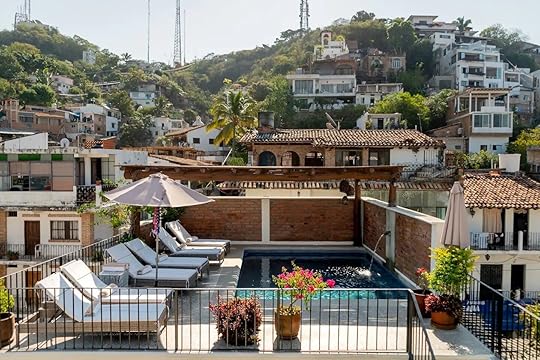
Photo: Airbnb

Photo: Airbnb
Casa Luna Azul consists of a three-bedroom villa with a one-bedroom apartment. Each room is affixed to an en-suite while beds are fitted with cushy memory foam mattresses for peaceful nights (or afternoon naps). Feast on views of the Banderas Bay and old town from the private rooftop pool – a chilled margarita in your hand. Breakfast prepared by professional chefs is included in the base rate at this beautiful Puerto Vallarta Airbnb for foodies.
Twelve guests, four bedrooms
Price: $780 per night
Book here

Photo: Airbnb

Photo: Airbnb
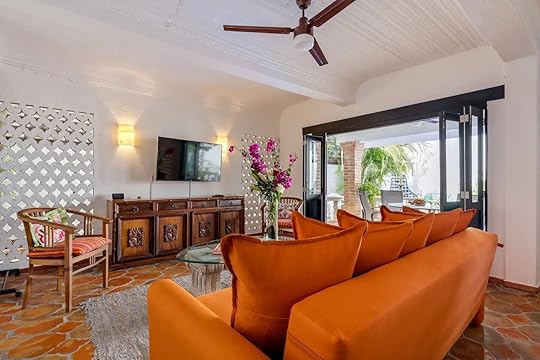
Photo: Airbnb
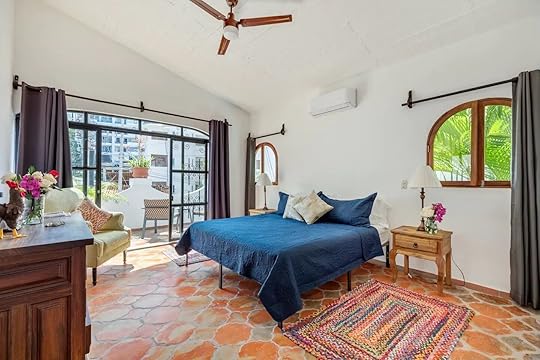
Photo: Airbnb
Casa Por Fin – “Home At Last” – recreates an authentic 1960’s Mexican residence in the Romantic Zone. Distinctive ceramic tiles, woven textures, and rustic furnishings harmonize the space with a homely vibe. When you’re not poring over the details, jump in the outdoor pool for laps under the PV sunshine. The garden features ample space for sunbathing as well as a protected dining area where you can gorge on guac and tacos. Breakfast is included in the rental fee with the option to add additional meals at a reasonable rate.
Eight guests, three bedrooms
Price: $440 per night

Photo: Airbnb

Photo: Airbnb

Photo: Airbnb

Photo: Airbnb
This swanky family-friendly Airbnb at the Puerto Vallarta Marina overlooks the golf club and provides tranquility a stone’s throw from central PV. The vacation home is neatly appointed with superior quality fixtures and furnishings while the outdoor plunge pool is exactly what you need after a day of exploring the Old Town. Staying at Villa Goretti grants access to a communal pool shared with other residents of the Villas del Country gated community.
Seven guests, four bedrooms
Price: $500 per night
Taking a trip to Mexico? Check out Matador’s Mexico accommodation guides:The best Airbnbs in and around Mexico City’s historic center8 La Condesa Airbnbs to settle into Mexico City’s coolest neighborhood8 stunning Polanco Airbnbs in the CDMX’s most international neighborhood11 Coastal Airbnbs and Hotels in Puerto Escondido With Ocean Views and Beach AccessThese Top-Rated Tulum Airbnb Rentals Put You Right Near the BeachBest Puerto Vallarta Airbnbs for HoneymoonersCasa Montaña – elegant small villa with private pool and ocean views
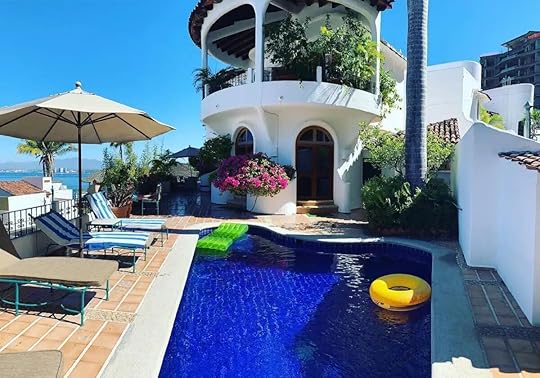
Photo: Airbnb

Photo: Airbnb

Photo: Airbnb
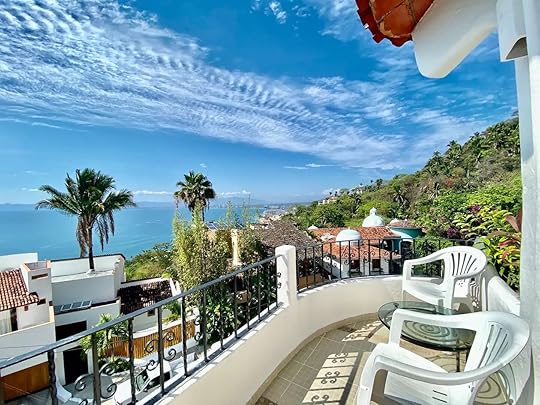
Photo: Airbnb
Casa Montaña is constructed following a traditional Mexican style. The villa sits atop a hill that overlooks the ocean and is five minutes from Concha Chinas Beach. The private pool is surrounded by tropical flora and foliage while both en-suite bedrooms have the benefit of a private balcony. Breakfast is included and you have the option to hire the same chef to whip up additional meals. With two double bedrooms, this beachside Puerto Vallarta bed and breakfast villa is suitable for small groups of friends or for a couple seeking a romantic hideaway.
Four guests, two bedrooms
Price: $370 per night
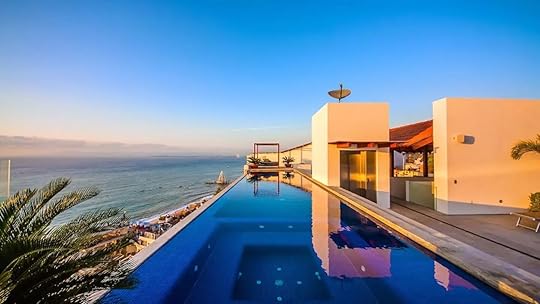
Photo: Airbnb

Photo: Airbnb

Photo: Airbnb

Photo: Airbnb
This luxury Airbnb Puerto Vallarta’s Romantic Zone (Old Town) provides ocean views from every room – even the bathroom! Your spacious balcony is fitted with a private hot tub where you can wind down with a bottle of bubbles at sunset. As a guest of this boutique residential block, you’ll have access to the rooftop infinity pool and shared barbecue facilities.
Three guests, one bedroom
Price: $285 per night

Photo: Airbnb

Photo: Airbnb

Photo: Airbnb

Photo: Airbnb
You’ve hit the jackpot with this oceanfront paradise that overlooks the Los Arcos Marine Sanctuary. The home features an infinity pool, hot tub, full gym, and direct access to the beach. Gigantic rooms and living spaces populate this supersized PV vacation home. Your booking includes airport transfers, water taxis, massages for up to four guests, complimentary meals prepared by a pro chef, and even the cost of the food. Had one too many tequilas? The elevator will get you safely up the stairs to your room.
Sixteen guests, nine bedrooms
Price: $2,500 per night

Photo: Airbnb

Photo: Airbnb

Photo: Airbnb
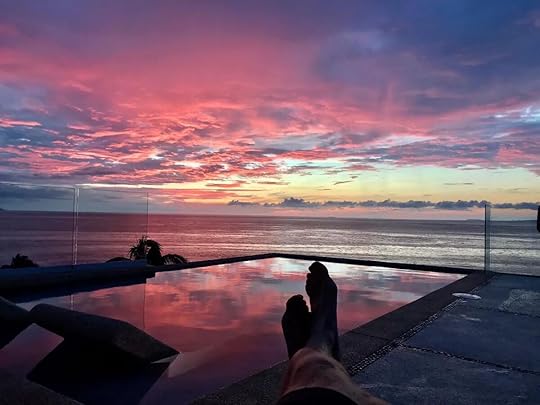
Photo: Airbnb
After front row seats for those legendary PV sunsets? This fashionable Puerto Vallarta beachfront Airbnb comes with its own roof deck and infinity pool for VIP access to golden hour. The lower living room opens out onto a second pool with sea views. Constructed in 2020, the villa benefits from state-of-the-art contemporary styling that remains faithful to Mexican elements. There are multiple desks in case you’re planning a workation and a foosball table for rallying some light competition.
Ten guests, five bedrooms
Price: $1,400 per night

Photo: Airbnb
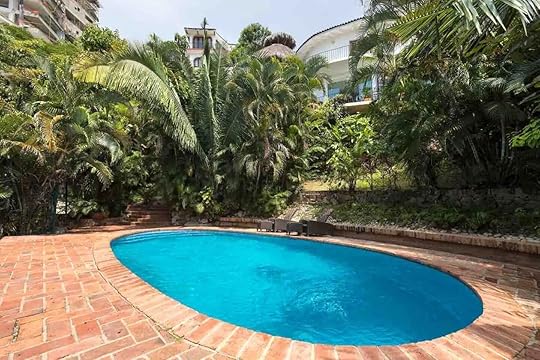
Photo: Airbnb

Photo: Airbnb

Photo: Airbnb
Let your mind be blown by the residence of the acclaimed Mexican artist and sculptor, Sergio Bustamante. Part home, part museum, this Puerto Vallarta Airbnb is adorned with Bustamante’s artworks. The private swimming pool is buried among tropical greenery while strategic balconies and immense windows make it impossible to avoid getting an eyeful of the ocean. Follow the private footpath down from the backyard and you’ll be at Conchas Chinas Beach before you know it.
Eight guests, three bedrooms
Price: $840 per night

Photo: Airbnb

Photo: Airbnb

Photo: Airbnb

Photo: Airbnb
This three-story Airbnb in the Puerto Vallarta Romantic Zone bursts with color courtesy of stained glass windows, intricate tiling, and lashings of soft furnishings. Oceanview bedrooms and palatial en-suites mean there’s no excuse not to indulge in siestas and pampering sessions. The backyard consists of a private pool and palapa den where you can listen to the sound of the water fountain, birdsong, and the ocean.
Eight guests, four bedrooms
Price: $550 per night

Photo: Airbnb

Photo: Airbnb

Photo: Airbnb
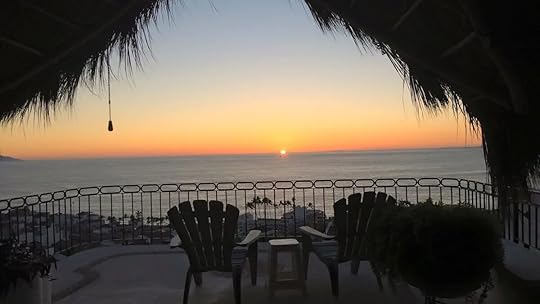
Photo: Airbnb
Centrally located in Colonia 5 de Diciembre, this knockout Airbnb on the Puerto Vallarta beachfront lets you ogle the Banderas Bay to your heart’s content. Multiple balconies, terraces, and an open-air lounge with your own bar invite the tropical sun and ocean breeze to swish throughout the house. An infinity pool is attached to a hot tub while Camarones Beach is within walking distance. 
Six guests, three bedrooms
Price: $300 per night
Book here
Happy birthday in 40 languages

Travelers have friends in every corner of the world. And whether they talk every week or just a couple of times a year (at New Year, for example), the best way to keep the connection alive is to know how to wish your international friends a happy birthday in their own language. Receiving a card, or a simple text, with a birthday note in your native tongue from a far-flung friend makes the occasion special — it’s an act of kindness that won’t be soon forgotten.
The list below will teach you how to say “Happy birthday” in different languages – 40 of them, actually! So bookmark it, and when the occasion comes up to send your good wishes to your friend who lives far away, you’ll have everything you need to make them feel appreciated.
Happy birthday in different languages from A-ELanguageSpellingPronunciationAfrikaansGelukkige verjaarsdagKheluk-uh-khuh fer-yaar-shdarhAlbanianGëzuar ditëlindjenGez-oo-ar dit-eh-lind-yenArabicكل سنه وانت طيب (to a man)سنة وانتِ طيبة (to a woman) Ko-lo Sa-na ua In-ta ta-yab (to a man)
Ko-lo Sa-na ua In-ti ta-ya-ba (to a woman)Azerbaijani (Azeri)Ad günün mübarəkAd-gunun-mubaarekBahasa melayu (Malay)Selamat hari lahirSi-lu-mat ha-ri la-heerBasqueZorionak zuriSo-rio-nak Su-reeBosnianSretan rođendanSre-tan ro-djen-denBulgarianЧестит Рожден денChes-tit ro-jden denCatalanPer molts anysPalr-moz-anyisCzechVšechno nejlepší k narozeninámfchek-no ney-lep-chik na-ro-ze-nyi-naamaDutchFijne verjaardagFay-ne ver-yaar-darhEstonianPalju õnne sünnipäevaksPa-liu od-ne shu-ni-pa-vaks
Happy birthday in different languages from F-LLanguageSpellingPronunciationFarsi.تولدت مبارکTa-wa-lu-dit mu-ba-rakFilipino (Tagalog)Maligayang kaarawanMa-li-ga-yang ka-ra-wanFrenchJoyeux anniversaireJoa-yieh za-ni-ver-serGermanAlles Gute zum GeburtstagA-les Gu-tuh dzum Guh-bor-stakGreekχαρούμενα γενέθλιαHa-ru-me-na dje-ne-thliaGujaratiજન્મદિવસ ની શુભકામનાઓJan-ma-di-vas ni sub-hka-mnaoHebrewיום הולדת שמחYom Hoo-leh-det sa-may-achHindiजन्मदिन की शुभकामनाएंDjan-ma-din kee shub-kaa-mnaenHungarianBoldog születésnapotBol-dog su-la-te-shna-potIrish Gaeliclá breithe shona duitLaw breh-ha sun-ah ditchItalianbuon compleannobuon kom-ple-anoJapanese誕生日 おめでとうTan-djo-bee o-me-de-toKorean생일 축하합니다san-gil chu-kaha-mni-da
Happy birthday in different languages from M-ZLanguageSpellingPronunciationMalteseAwguri f’għeluq sninekAu-goori feh-looq snee-nekMandarin Chinese生日快乐Shun-gri kway-luhMaoriRā Whānau ki a KoeRaah faah-nuh kyaa qwehNorwegianGratulerer med dagenGra-too-ler me-daa-genPolishWszystkiego najlepszego z okazji urodzinVshi-stkye go nay-lep-shee-go zoka-zyi oo-roo-jeanPortugueseFeliz aniversáriofleez ani-ver-saa-rioQuebec FrenchBonne fêtebon fetRomanianLa mulţi aniLa mul-tsi aniRussianС Днём рожденияSdnyem rosh-deni-yaScottish GaelicLà breith sona dhuitko-la-brey so-na-gurtSpanish feliz cumpleañosfe-lis coom-play-anyosThaiสุขสันต์วันเกิดSuk san wan guuhdTurkishİyi ki doğdunEe-kyi do-doonUrduآپ کوجنم دن مبارک ہوap ko ja-nam din Mu-ba-rak hoWelshPenblwydd HapusPen-bluith haa-pis
Do you know how to say “Happy birthday” in any other languages? Share it with us so we can get closer to representing the world’s thousands of languages! 
What It’s Like To Be a Resident Magician on the US’ First Adult-Only Cruise Ship

If you’ve seen Below Deck, you’ve probably wondered what it’s like working on a cruise ship. Maybe you’ve even considered applying for a position yourself, drawn by the tempting prospect of traveling the world for free with a cast of crazy characters.
Living on a cruise ship has always had a certain allure. The excitement of waking up in a new place every day, cohabiting with like-minded free spirits, the revolving door of new passengers, the possibility for romance — it’s no surprise the lifestyle is so appealing, and that so many take advantage of it.
For a truly unfiltered take on what it’s really like to work on a cruise ship, we spoke to a “Happenings Cast” member, Andy, on Virgin Voyages — the first adult-only cruise line in the US.

Photo: Virgin Voyages
The Happenings Cast is composed of 14 cast members, each with a different talent for entertaining passengers. Andy is the resident “Charmer” on Virgin’s Scarlet Lady ship. His job is to charm passengers with impromptu magic performances throughout the ship and provide guests with a memorable onboard experience. He’s spilling the tea on everything from his living situation, to how the crew spend their free time, and how to work on a cruise ship in the first place.
Matador: What’s the process like of getting hired to work on a cruise ship (particularly in entertainment?) Is it at all similar to other jobs?Andy: I worked as a bartender for 13 years, so getting hired as an entertainer was a brand new experience for me. A friend of mine who’s also a magician had received the casting notice from his agent and passed the opportunity along to me. I went for the audition and didn’t really understand the magnitude of what I was getting into, but knew I was looking for a new direction in my life. To be honest, I would have been a lot more nervous if I knew how big the role was or that the Virgin Voyages entertainment team was conducting a worldwide search. I got the gig about a month after the audition and the crew made me feel welcomed from the get-go.
For my first event, I went to a big launch party in Sydney and met Sir Richard Branson. It was a surreal moment and made me feel like, “Wow, this is all happening.” After that event, I packed up my life in Australia and moved back to the UK for a month then joined the crew in New York. We rehearsed for three weeks before getting on board Scarlet Lady and my adventure started from that point.
The hiring process for the Happenings Cast is quite different from other crew because we go through an audition process whereas our other crew work directly with HR. I remember feeling very looked after by Virgin Voyages throughout the hiring process.
What are cruise ship crew quarters like?Yes, I have my own room with a double bed and a single bathroom. Virgin Voyages has a higher percentage of single-occupancy cabins than most cruise lines. I love that for our crew and it promotes good mental health. We also get to personalize the cabin a bit. Mine, for example, has cards signed by passengers.
Do you eat the same food passengers eat, what is crew food on cruise ships like?We have the privilege of dining in The Galley restaurant alongside passengers or we can go to Kitchen Table, which is our crew dining area. We love socializing with passengers so the Happenings Cast, specifically, can also make reservations at any of our six restaurants or join passengers if they invite us to dine with them. We always want to put our passengers first, so availability for our team is based on demand.
Are you able to get off the ship and explore ports?Yes, we can get off the ship and explore, especially now that the world is opening back up. We still take precautions and follow all of the safety policies such as wearing masks.
Getting shore leave is one of the major advantages of working on the ship. Depending on our show schedule, the Happenings Cast often has some free time during the day to explore the destinations we visit. My favorite port is Cozumel, Mexico. It’s a brilliant place with a good mix of authentic Mexico and sights and attractions. There’s also a famous bar called No Name Bar geared towards crew members and it’s like a little community for fellow ship crew.
How much do crew members make on cruise ships? Is the money good, or is the perk of working on a cruise ship basically sailing around the world for free?I’d say that the phrase ‘traveling the world for free’ can be replaced with ‘compromising what can be considered a normal life for unknown adventure and spontaneity.’ It’s very different from traveling the world for free because it comes with curfews and having to remain on a schedule. It might seem like a holiday, but crew life isn’t normal; it is however surreal and a lot of fun.
I got a magic kit for Christmas at eight years old, and I still get to do what makes me happy every day. If I were getting paid a comparable amount of money on land, it wouldn’t be the same because I love being on board. Working for Virgin Voyages has expanded my repertoire as I’ve had the chance to be a part of our signature Scarlet Night and shows like Never Sleep Alone. Seeing the world is a huge perk as well. There’s a certain way of life that you don’t get on land.
Living on a cruise ship year-round, do you ever get sick of being at sea, away from family, or disconnected from WiFi?Crew are offered WiFi at no cost, just like our passengers. Part of the job is sharing our experience on social media so having strong WiFi is so important. Virgin is so proud of its crew and they encourage us to share that with the world.
No, I never get sick of being at sea — it’s the most magical thing. I can’t imagine doing this anywhere else.
Do staff get discounts for onboard shopping?Yes, one of the perks for our entire crew is discounts on shopping onboard, at our Squid Ink tattoo shop, at Redemption Spa and for shore excursions. I actually just got a new tattoo a couple of weeks ago on board Valiant Lady.
What do you do in your free time?The Happenings Cast has access to the passenger gym and crew gym, so I love getting in a HIIT workout or jogging on The Runway — our running track that encircles the ship. I also love being out in the open air at The Perch at the back of the ship on deck 17. It’s a great spot to practice juggling or work on new magic content.
Can you socialize with passengers in your off-hours?Rather than having a traditional cruise director, Virgin wanted to switch things up, which is where the Happenings Cast comes into play. We’re meant to bring a vibe and energy to different areas around the ship and are definitely encouraged to interact with our passengers to help make sure they have an incredible voyage.
While working, do you always have to be “on” in front of passengers or are you allowed to be yourself and socialize?The reason why we got the job in the first place is because we are ourselves. I think the hiring team could have sussed out if we weren’t being genuine or authentic. All of that to say, there is no “on.” Even if I’m not clocked in, I still enjoy interacting with our guests — you have to be like that to enjoy this job.
Are relationships (both serious and casual) common among crew members?Over the past two years, I’ve met some of the best, most interesting people; people I’ll probably be friends with for a lifetime. It’s kind of amazing to surround yourself with other entertainers as it makes me want to push my limits and become a better performer myself.
What’s the craziest thing you’ve seen while working on a cruise ship?Haha, people can get really into the show and occasionally throw me a curveball, but honestly, it keeps me on my toes and makes me a better performer. Our crew is truly amazing and we know how to connect with people who are really enjoying the experience. For me personally, the craziest thing was doing a magic show for Richard Branson and Paris Hilton when we launched in New York last fall. 
April 14, 2022
Here’s How Much Inflation Has Increased the Cost of Airfare, Hotels, and Rental Cars

Inflation is making just about everything more expensive in the United States as it rises at the fastest rate since 1981. The cost of travel is no exception.
According to data from the Federal Reserve, gas (48 percent increase year-over-year), hotel rooms (25.1 percent), airfare (23.6 percent), rental cars (23.4 percent), and transportation (22.5 percent) have all increased in price significantly more than the 8.5 percent increase of the overall Consumer Price Index.
View this post on InstagramA post shared by Yahoo Finance (@yahoofinance)
The cost of fuel is behind much of the increase. It’s simply more expensive to get anywhere or move anything, and that cost is passed on to consumers. Jet fuel alone costs more than 30 percent than it did last month, according to TravelPulse. Other factors impacting the travel industry include staffing shortages (especially in the case of airlines, which have had to cut back the number of flights) and a surge in demand from people eager to travel again after years of staying close to home.
You can still make travel affordable if you put in the effort. There are reward programs for every type of traveler, and some days are cheaper to buy flight tickets than others. In some cases, you can buy two one-way tickets and end up with a cheaper option than buying a round-trip flight.
If one thing is for certain, it’s that prices aren’t going to magically go down anytime soon, but there are plenty of budget travel hacks to keep down the cost of getting out into the world.
More like thisNewsNew Study: How Far Ahead You Should Buy a Flight for the Cheapest Prices in 2022The 10 Hardest Hikes in California Only Experts Should Attempt

Sure, lots of states have challenging hikes — looking at you, Colorado. But what California lacks in 14’ers it makes up for in diversity, from the furnace-like heat of hiking in the southern California desert to the rainy, mist-filled forests of the northern “Lost Coast.”
That said, California does have 14ers, in fact — 15 of them. It also has both the highest and lowest points in the lower 48, with Mt. Whitney at 14,505 feet above sea level and Badwater Basin in Death Valley National Park at 282 feet below sea level. Depending on where you are in California, you could be hiking muddy trails to massively lush waterfall basins, trekking through snow above treeline in the Sierra Nevada, or overlooking the city of San Diego at the Insta-worthy Potato Chip Rock. And with nine national parks and 20 national forests, plenty of California’s hiking trails are protected from development.

Photo: Galyna Andrushko/Shutterstock
But if you’re a dedicated hiker, you probably know that “Type Two” fun still counts as fun, and may be looking for some leg-burners to add to your to-do list this summer. Sure, the hardest hikes in California are long, but they’re also steep and varied, with everything from narrow single-track along steep cliffs to windy, rocky peaks where a wrong step could send you tumbling down a thousand feet. If you want to add one or two of the hardest hikes in California to your resume, explore the list below.
The 10 trails highlighted cover northern and southern California and include both single-day and distance hikes. And don’t take the warnings lightly about their difficulty — people train for months (even years) to be ready to tackle some of these routes.
The Hardest Hikes in Northern CaliforniaMt. Whitney
Photo: Mariusz S. Jurgielewicz/Shutterstock
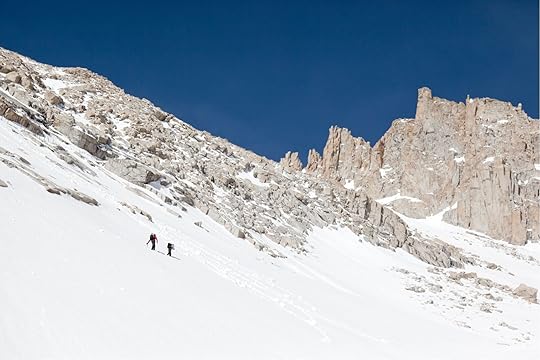
Photo: Photo: Galyna Andrushko/Shutterstock

Photo: Nadia Yong/Shutterstock
Distance: +/- 21 milesTotal elevation gain: +/- 6,650 feetMax elevation: 14,505 feetIf you’re at all familiar with hiking in California, you may be surprised to see Mt. Whitney on the list of the hardest hikes in California, rather than on a list of hard distance hikes. But that’s because cranking out all 21 miles of Mt. Whitney in a day adds an extra level of difficulty. Rather than basecamping halfway up the mountain and waking up early for a sunrise summit, single-day hikers will start at an elevation of 8,600 feet — already enough for a severe case of altitude sickness — and make it all the way up and back down in time for sunset (ideally).
Obviously, this wild effort should only be attempted in summer and early fall, both to maximize daylight and reduce the likelihood of needing snow spikes or traction devices near the top. Expect wild weather near the summit; rain and strong winds are common at the crest, even when it’s dry and sunny at the bottom. Day-use permits are required (and competitive). More information.
Half Dome
Photo: Slberto Loyo/Shutterstock
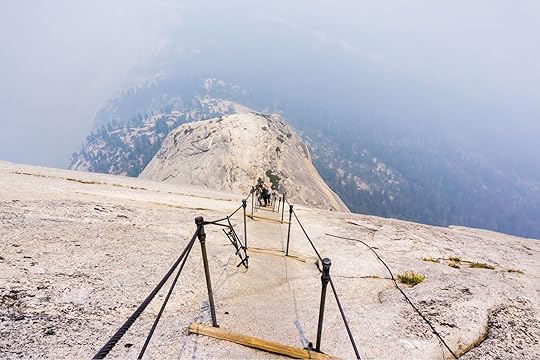
Photo: Sundry Photography/Shutterstock

Photo Suzie Dundas
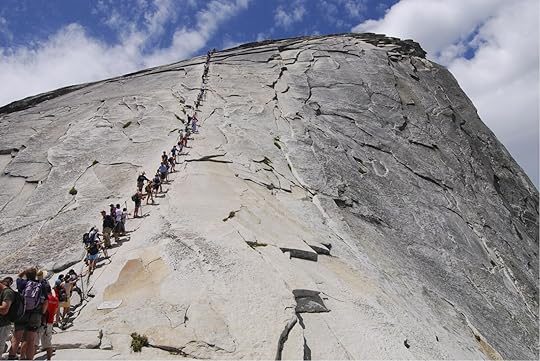
Photo: Mark Yarchoan/Shutterstock
Distance: +/- 16 milesTotal elevation gain: +/- 5,200 feetMax elevation: 8,840 feetOn paper, Half Dome isn’t the hardest hike on this list by distance or elevation, though it does clock in at a reasonably long 16 miles if you start from the Yosemite Valley floor. But it’s the route’s infamous cables — and their associated fear factor — that make this California hike such a doozy. The cables are the only thing keeping hikers grounded along the steep, 1/4-mile climb along a slick rockface to the top. And yes, when someone is coming down the cables, you need to let go to let them pass. And there will be hikers behind you, so there’s no time to stop if you get nervous. In other words, if you’re afraid of heights, stay back at camp.
However, for most people who have done Half Dome, the actual cables aren’t the hardest part. That honor goes to the sub-dome, a smaller dome just before the cables. It’s just as steep but without any sort of handrails or breaks. It gains 600 feet via several switchbacks in just 1/4th of a mile, and with few trees and giant steps, it’s a massive leg burner. And just when you finally finish, well, that’s when it’s time to trek up the actual cables. Bring more water than you think you’ll need.
As with most of the hardest hikes in California, you need a permit. You can hike to the base of the cables without a permit and if you’re lucky, you may find someone who chickens out and lets you use their space to get to the very top. But park rangers are usually nearby to check permits, so you don’t want to risk getting caught without one. More information.
Mount Shasta via Avalanche Gulch
Photo: Robert Cornell/Shutterstock

Photo: Stephen Moehle/Shutterstock
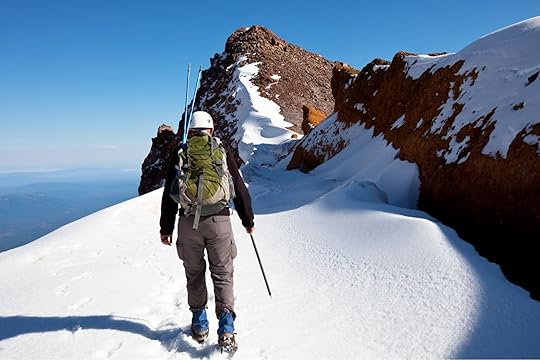
Photo: Galyna Andrushko/Shutterstock
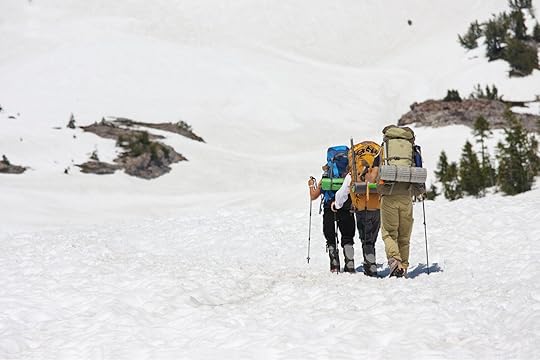
Photo: Radoslaw Lecyk/Shutterstock
Distance: +/- 10.5 milesTotal elevation gain: +/- 7,120 feetMax elevation: 14,180 feetThough Mt. Whitney may get most of the attention in California for its superlative height, it’s Mount Shasta, to the north, that’s arguably more difficult. In fact, it hardly counts as a hike and could more be considered a mountaineering endeavor, especially as there’s no set trail.
Sure, most people take more or less the same route, but if you’re hoping for a clear path, think again. Add in the year-round need to traverse across snow with ice axes and crampons and the risk of avalanches and unexpected crevasses in ice — not to mention wild weather — and it’s clear why it’s often considered the hardest hike in California. Unless you have a death wish, you should go with a guide your first time if you’ve never mountaineered.
You’ll need a permit to attempt Mount Shasta, but surprisingly, there’s no quota system — they’re self-issued at the trailheads. If you plan on hiking above 10,000 feet, you’ll also need a summit pass, which you can get at the Mt. Shasta Ranger Station or at a self-issue station if you have exact cash ($25 per person). Many climbers do this as a multi-day hike with professional guides. It’ll still be one of the hardest hikes in California you’ve ever done, but at least you’ll have a dedicated safety and camping team to help you to the top. More information.
Grizzly Falls via China Gulch
Photo: DimiB Photos/Shutterstock

Photo: DimiB Photos/Shutterstock

Photo: DimiB Photos/Shutterstock

Photo: Volodymyr Osypov/Shutterstock
Distance: +/- 20 milesTotal elevation gain: +/- 5,090Max elevation: 7,120 feetGo hard or go home, right? In the case of Grizzly Falls, “go home” is the choice for most people as the hike tops many a list of the hardest hikes in California. That said, the views at the top are some of the best in California. The trail’s highest point is atop Grizzly Falls, where hikers will stand on a narrow band of rocks with 150-foot Grizzly Falls on one side and a beautiful alpine lake on the other. But Mother Nature makes you work for the pleasure of standing there, and hikers will traverse some of the hardest non-technical terrain California has to offer.
Along the trek, expect steep rock stairways, loose shale, tight switchbacks, stream crossings, and a downhill followed by a grueling climb back up. And just before reaching the summit (but after a few steep sections that’ll tax your leg muscles), you’ll reach what’s known as the Grizzly Creek scramble: a rocky final push without a clear trail you’ll have to navigate using your feet and hands. It’s not incredibly hard as far as scrambles go, but add on the fact that you’ll already have climbed nine miles to reach it, and you can see why it’s developed an intimidating reputation.
Ambitious hikers can do this as a one-day trek, though there are backcountry camping sites at a few locations along the route. You’ll need a permit, which you can get on the way at the Weaverville or Shasta Lake ranger stations. More information.
Hardest Hikes in Southern CaliforniaTelescope Peak
Photo: yhelfman/Shutterstock

Photo: Sundry Photography/Shutterstock

Photo: Asim Patel /Shutterstock

Photo: National Park Service/Jennette Jurado
Distance: +/- 12.8 milesTotal elevation gain: +/- 3,320 feetMax elevation: 11,043 feetIt’s probably not a shocker that a place called Death Valley would be home to one of the hardest hikes in California. But what may be shocking is that the summit of Telescope Peak is around 11,000 feet above sea level — which is 11,280 feet above the lowest area of the park (which happens to be well below sea level). Fortunately, the hike for Telescope Peak starts from the park’s Mahogany Flat Campground, which eliminates much of the difference as the campground is about 8,200 feet above sea level.
The hike starts in a forest but quickly opens to massive views of the park, followed by steep and dry climbing through high desert. The final quarter-mile or so is along a fairly narrow ridgeline known for strong wind and gusts, so make sure you take off any baseball caps.
The elevation gain is fairly well distributed, but there’s no water along the trail and it’s exposed to the elements nearly the entire way. In late spring, the trail could be dusty and dry at the bottom but icy and dotted with snow patches closer to the summit. Be sure to keep an eye on the weather forecast and don’t even think about attempting it if there’s potential for a storm anywhere nearby.
If you do make it to the top, look north to see one of the other hardest hikes in California in the distance: Mount Whitney. More information.
Cactus to Clouds via the Skyline Trail
Photo: Andy Konieczny/Shutterstock

Photo: AJ9/Shutterstock

Photo: KhanIM/Shutterstock

Photo: AJ9/Shutterstock
Distance: +/- 19 milesTotal elevation gain: +/- 10,330 feetMax elevation: 10,834 feetCactus to Clouds is a really, really difficult hike. That elevation gain isn’t a typo: it seriously gains more than 10,000 feet of elevation in a single day. Most hikers start very early in the morning with headlamps to even have a chance of finishing it before dark — and to ensure they aren’t climbing in the daytime desert heat, when temps can be well over 110 degrees Fahrenheit. Cactus to Clouds often tops lists of the hardest hikes in California — and if you don’t see it on similar lists, it’s probably because most people consider it undoable in a day. But it’s not, if you’re extremely fit and experienced.
The hike begins in Palm Springs at an elevation of around 500 feet above sea level before finally reaching San Jacinto Peak at an elevation of 10,834 feet above sea level. As if the insane elevation gain and distance weren’t enough, there are several other factors that help this hike earn its reputation.
First, planning for the weather is tricky. You don’t want to do it in the middle of summer as the temperatures in Palm Springs and for the first few miles on the trail will be unbearably hot and lead to heatstroke — but you also don’t want to go too early or late in the year as you’ll hit snow much higher up toward San Jacinto Peak. Most hikers do it mid-fall.
You’ll also have to deal with arranging transportation as it’s a point-to-point hike, and make sure you get the appropriate permits at the appropriate locations (you’ll need a backcountry permit when you get into the San Jacinto Wilderness). There’s no water until mile 10, you’ll need to keep an eye out for both nighttime and daytime critters that can hurt you (like snakes and spiders), you’ll have to carry much more than usual in case you do get lost or delayed, and the trail’s numerous crossings and turns can be confusing if you don’t know how to read your map.
It’s pretty well-known that this is one of the hardest hikes in California — so much so, in fact, that police mounted two “rescue boxes” along the trail with supplies for hikers in trouble. Don’t take anything out of the box unless you really, really need it. More information.
San Gorgonio Peak
Photo: AllTrails

Photo: AllTrails
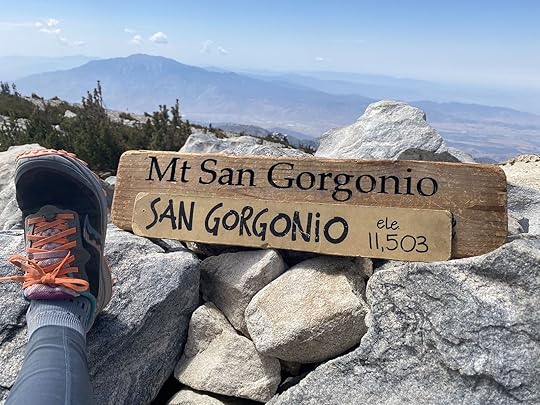
Photo: AllTrails

Photo: AllTrails
Distance: +/- 19 milesTotal elevation gain: +/- 5,500 feetMax elevation: 11,500 feetSan Gorgonio Peak is the tallest peak south of the Sierra Nevada and with some steep climbs and extended exposed sections, it’s just as intimidating as its northern California counterparts. Less than half a mile out of the gate, you’ll face a series of steep switchbacks, and if that has your legs burning, just you wait. The trail has very few flat sections and is mostly uphill the entire time. The middle section is forested and lush (at least in spring and summer), but it’s exposed and rocky at the top with very strong winds. Even with sunscreen, you’ll probably have some serious windburn by the time you start the hike back down.
It’s important to start early in the summer, both to beat the heat and to find parking — despite the challenge, this trail is popular. It’s also a popular hike for adventurers training for Mount Whitney since it follows a similar elevation profile. You need a permit to hike it, and while they’re free, they’re also limited. The Vivian Creek trailhead is kind of in the middle of nowhere, so most people will want to camp in the nearby San Bernardino National Forest, where dispersed camping is allowed as long as you follow a few basic regulations. More information.
Hardest Long-Distance Hikes in CaliforniaThe Pacific Crest Trail
Photo Patrick Poendl/Shutterstock

Photo: chrisontour84/Shutterstock

Photo: Bob Pool/Shutterstock

Photo: Modern Meta Photography/Shutterstock
Distance: +/- 2,600 milesTotal elevation gain: +/- 824,370 feetMax elevation: 13,153 feetThe PCT is one of the longest distance hikes in North America and it’s not a “take a long weekend next summer to do it”-type of hike. The PCT requires serious knowledge and training. You’ll likely need to quit your job or at least take an extended leave of absence, since most people take about five months to go from the starting point near the Mexico-California border to the ending point at the Canadian border.
Most people cover about 15 miles a day and it’s far more common to do it south-to-north. This allows you to start the long segments in the desert before the middle-of-summer heat kicks in and means you won’t hit the Sierra Nevada mountains until most of the snow has melted.
But don’t think starting in the desert makes things easier. You’ll have to go more than a week without a chance to resupply and will be at the mercy of the heat, wind, and elements — don’t expect lots of tree cover if a storm rolls in. We can’t even begin to give enough information here to stress how challenging the hike is, even for expert athletes, so just take a look at this video from a Pacific Crest Trail hiker who took one photo every mile of the journey. It’s a physically demanding effort. More information.
The Lost Coast Trail from Shelter Cove
Photo: Geartooth Productions/Shutterstock

Photo: James R T Bossert/Shutterstock

Photo: Geartooth Productions/Shutterstock

Photo: Christer Dabu/Shutterstock
Distance: +/- 25 milesTotal elevation gain: +/- 1,600 feetMax elevation: 132 feetWhen you think of California’s coastline from south to north, what’s the order? San Diego, Los Angeles, Monterey Bay, San Francisco, and then….what? If you’re familiar with California, you may say Mendocino or Eureka. But the fact is that the coastline north of San Francisco is almost as long as the coastline south of San Francisco — but it’s a lot harder to reach.
With no roads and very little development, the area known as California’s Lost Coast is one of the last remaining sections of California’s coastline left in its original state. It’s where you’ll find the Lost Coast Trail, which isn’t particularly taxing by numbers but packs a punch when it comes to weather and coastal conditions. The terrain is so rugged that Highway 1, which hugs California’s coastline everywhere else in the state, moves inland here as it was just too difficult to build in this area. Much of the hike is through rock and sand (i.e. unsure footing), which is extremely taxing on your legs.
On top of that, it rains — a lot. And even if it’s not raining, you can expect to almost always be damp from the breezes blowing saltwater in off the ocean. Oh, and you have to time it right with the tides or you’ll find yourself trapped on rocks for hours until the route becomes visible again under the waves. And don’t expect cell service or any nearby amenities.
Those challenges aside, it’s a beautiful hike and unlike anything else in California. Most hikers do it in three days since they’ll generally move slower across sand. You can do it as an out-and-back hike, and you can start in the north or the south. Just don’t be fooled by the low elevations — the fact that it’s so close to sea level is what makes it so mentally difficult. More information.
The Tahoe Rim Trail
Photo: Jordan BC /Shutterstock

Photo: Suzie Dundas

Photo: Andy Konieczny/Shutterstock

Photo: Suzie Dundas
Distance: +/- 170 milesTotal elevation gain: +/- 27,900 feetMax elevation:10,338 feetTechnically, some of this trail is in Nevada. But it still counts, especially as it’d be one of the hardest hikes in California even if you cut off the entire Nevada section.
As you may expect, the Tahoe Rim trail circumnavigates Lake Tahoe, which has 72 miles of shoreline and is nearly 22 miles long. Because the trail has to wear around major geological features and mountainous terrain, it’s much longer — 170 miles, to be exact. And if you thought you’d climb into the mountains, circle the lake, and climb down, think again. The route has no less than a dozen climbs that gain well over 1,000 feet of elevation. Most hikers take about two weeks to do it, though speedy hikers can probably do it in closer to 10 or 11 days.
Unfortunately for summer hikers, tackling the Tahoe Rim Trail is not akin to a warm lake vacation. It’s not uncommon to have daytime temperatures around 80 degrees Fahrenheit but nighttime temperatures below freezing. And campfires aren’t allowed — you’re in forest-fire territory, after all.
If you’re lucky, you’ll get to see a few bears and maybe a mountain lion, which does mean you’ll have to carry all your food in a bulky bear bin the whole time. The north shore is generally considered the most challenging, especially after a big snow year. There are a few resupply stations along the trail and like the PCT, many people mail themselves supplies in advance to pick up along the way.
It’s challenging, rocky, cold, and will put you at risk of elevation sickness, but if you’re willing to do it, you can expect near-constant vistas of alpine lakes and forests, valleys filled with wildflowers, and some of the most peaceful backcountry campsites you’ll ever experience. You can also extend the trip by a week or so if you take some of the many side hikes off the main TRT route. More information. 
More like thisParks + WildernessThe 9 Hardest Hikes in the US National Park Service You Can Do in a Day
These Top-Rated Tulum Airbnb Rentals Put You Right Near the Beach

Tulum on Mexico’s Yucatán Peninsula marks the site of an ancient Mayan city that has boomed as a modern-day seaside resort. The town and beach strip attract honeymooners, traveling yogis, and families seeking jungle vibes, cenote swims, and photogenic accommodations. Our pick of Tulum Airbnb rentals range from ocean view villas and eco-chic treehouses to luxury penthouses.
Unique Airbnb Tulum treehousesRomantic Tulum Airbnbs for couplesAirbnb Tulum villas for larger groupsWe hope you love the Tulum Airbnb rentals we recommend! Just so you know, Matador may collect a small commission from the links on this page if you decide to book a stay. Listed prices are accurate as of the time of publication.
Unique Airbnb Tulum treehousesTouch the Sky at Hidden Treehouse
Photo: Airbnb

Photo: Airbnb

Photo: Airbnb

Photo: Airbnb
Dreaming about one of Airbnb’s Tulum treehouses right by the beach? Designed for a couple or a smaller group, this soulful treetop cabana overlooks the lush Mayan jungle while being steps away from the sand. It’s sustainably built with local bamboo and hemp and powered by solar energy. Two double bedrooms offer privacy and solitude in an unbeatable nature setting.
Four guests, two bedrooms
Price: $300 per night

Photo: Airbnb

Photo: Airbnb

Photo: Airbnb
This one-of-a-kind fuses the jungle setting with the action of the Tulum Beach Strip. The dome perches level with the tree line with strategic windows enabling you to stargaze from bed. Sink into the freestanding bathtub and tune into the ambient sounds of the forest. The perfect getaway for couples with pooches – dogs are welcome at this pet friendly Tulum Airbnb.
Two guests, one bedroom
Price: $220 per night
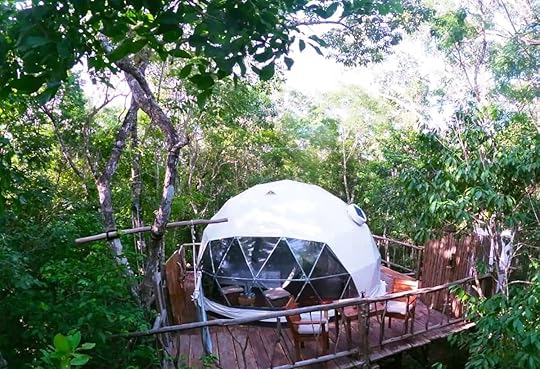
Photo: Airbnb

Photo: Airbnb

Photo: Airbnb

Photo: Airbnb
You’ll find this eco-friendly Airbnb Tulum treehouse dome tucked away off-grid, far from the bustle of the town and beach strip. The design enables you to connect with nature without sacrificing your comforts. Special touches include an outdoor shower and hammocks that adorn both the living quarters and the wraparound terrace. Wi-Fi is not provided; instead you are encouraged to stargaze, bathe in the local cenotes, and spend quality time with your spouse. The Gram can wait.
Two guests, one bedroom
Price: $110 per night
Taking a trip to Mexico? Check out Matador’s Mexico accommodation guides:The best Airbnbs in and around Mexico City’s historic center8 La Condesa Airbnbs to settle into Mexico City’s coolest neighborhood8 stunning Polanco Airbnbs in the CDMX’s most international neighborhood11 Coastal Airbnbs and Hotels in Puerto Escondido With Ocean Views and Beach AccessRomantic Tulum Airbnbs for couplesCasa Gaia

Photo: Airbnb
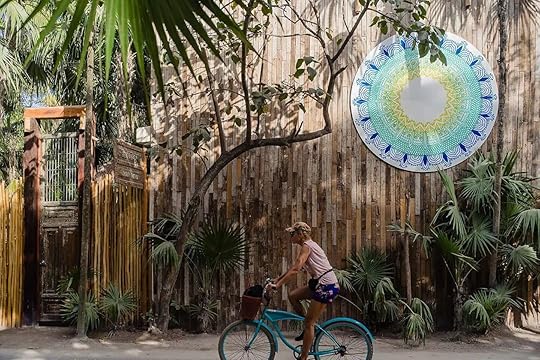
Photo: Airbnb

Photo: Airbnb

Photo: Airbnb
Escape the party scene at this Airbnb; your Tulum beachfront bungalow is located on the calmer patch of beach south of the strip. Casa Gaia is soft and sensual with curved walls, high ceilings, and a palapa roof. The one-bedroom beach villa is self-contained with a bathroom, kitchenette, and secluded balcony overlooking the sea. There’s a communal pool on site (shared with three other luxury villas) and you have unlimited access to boogie boards, kayaks, and more.
Two guests, one bedroom
Price: $650 per night

Photo: Airbnb

Photo: Airbnb

Photo: Airbnb

Photo: Airbnb
This tiny paradise consists of a minimalist interior with a private bathroom and basic kitchen. Sliding French windows lead you out onto a serene terrace with jungle views where you can loll beneath the Mexican sun. Indulge in leisurely afternoons swaying in the hammocks and cooling down in your Tulum Airbnbs’s private pool. Complimentary use of your own scooter during your stay makes cenote and beach hopping a doddle.
Two guests, one bedroom
Price: $215 per night

Photo: Airbnb
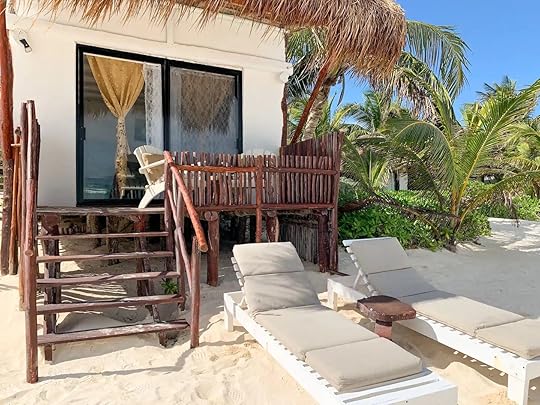
Photo: Airbnb

Photo: Airbnb

Photo: Airbnb
Top up your vitamin sea at this Airbnb on Tulum’s beachfront with your own private slice of beach. Spend lazy days alternating between the deck, the sun loungers, and dipping your toes in the turquoise Caribbean Sea. Bicycles and breakfast are included in your booking during your stay at this dog friendly beach cabin. There’s no need to set your alarm; the sunrise over the water will be your wake-up call.
Two guests, one bedroom
Price: $300 per night

Photo: Airbnb

Photo: Airbnb

Photo: Airbnb

Photo: Airbnb
The traditional vaulted palapa roof of this luxury Airbnb Tulum villa peeps out of the beachside palms and provides direct access to the white sand. Beautiful interiors are curated to reflect the culture of the Mayan Riviera and monopolize the ocean views. Take your pick of the boogie boards, stand-up paddleboards, and sea kayaks, or float in the pool, shared with the three other properties on the Mahayana Tulum complex.
Spend a night in at this Tulum Airbnb with chef services and ask the host if you want to add massages, excursions, and childcare services.
Six guests, three bedrooms
Price: $1,600 per night

Photo: Airbnb

Photo: Airbnb

Photo: Airbnb
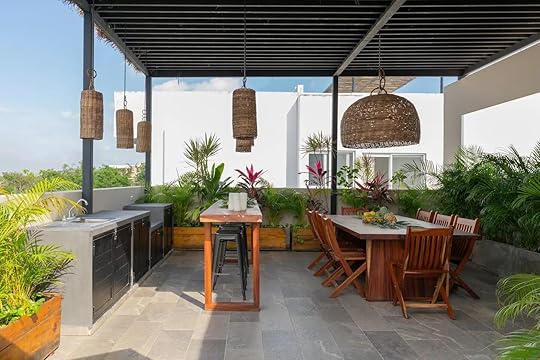
Photo: Airbnb
Located in the eco-haven of Aldea Zama in between Pueblo Tulum and Tulum Beach, this luxury penthouse offers the best of the resorts. The vacation rental straddles two floors and features a spacious rooftop terrace. Your Airbnb Tulum with private pool lets you survey the jungle surroundings from its rooftop position. You also have the simple delight of an outdoor shower and complimentary access to two bicycles.
Four guests, two bedrooms
Price: $215 per night

Photo: Airbnb

Photo: Airbnb

Photo: Airbnb

Photo: Airbnb
Tropical bliss awaits at this Tulum Airbnb with private pool in the desirable Aldea Zama neighborhood. The outdoor swimming pool is shrouded by thick jungle greenery and features a sheltered outdoor dining area. Spread over two floors, this eco-chic villa culminates with a rooftop with space to practise yoga – or crack open a bottle of mezcal – with a 360-degree view across the canopy.
Eight guests, four bedrooms
Price: $445 per night

Photo: Airbnb

Photo: Airbnb

Photo: Airbnb

Photo: Airbnb
Live out all your Instagram fantasies at this Tulum vila with a private pool festooned with a “floating” seating zone and waterside swings. The property is modern, sparkling clean, and flooded with natural light. The hosts of this luxury Tulum Airbnb with chef and bartender service are also able to arrange in-house massages, yoga classes, and sound meditation sessions.
Twelve guests, five bedrooms
Price: $920 per night

Photo: Airbnb

Photo: Airbnb

Photo: Airbnb
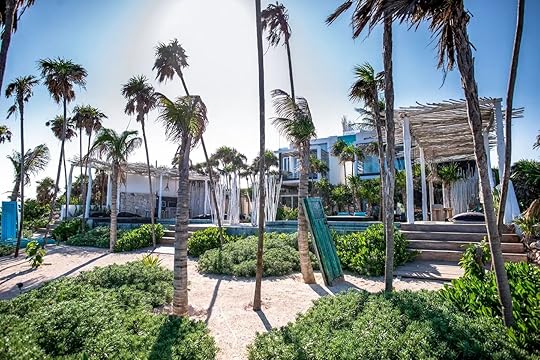
Photo: Airbnb
Situated at the northern tip of Tankah Bay, Casa Xuul Tulum consists of two identical sister villas. An expansive rooftop terrace with a clear bottom plunge pool connects the duo. Meanwhile, the ground floor opens out directly onto the beach with two additional pools. Interiors are appointed with stylish wooden furnishings and quality furnishings. Private decks strewn with hammocks and an outdoor bathtub make it easy to connect with nature.
Casa Xuul Tulum may be booked in its entirety. Smaller groups can reserve one of either of the two Tulum villas on Airbnb individually: Villa I’Ik and Villa Kiin. 
Sixteen guests, eight bedrooms
Price: $2,340 per night
Book here
In Vancouver, the City’s Innovative Hotels Double as Social Hubs

For the weary traveler, Vancouver’s greatest welcome comes in the form of rosé. I was handed a chilled pour upon check-in at OPUS, a 96-room boutique hotel in the city’s trendy Yaletown neighborhood, in early March.
“Once you’re settled, grab a bike and head to Stanley Park,” Matthew Hui, the hotel’s front office manager, advised me as he handed me the room key, referring to the grassy waterside reserve a few blocks from the property. He pointed to two Norco cruiser bikes neatly set against the lobby wall. I promised that I would.

Photo: Tim Wenger
We hope you love the Vancouver hotels we recommend! Just so you know, Matador may collect a small commission from the links on this page if you decide to book a stay. Listed prices are accurate as of the time of publication.
I felt sullen and haggard after a long day of travel that had included a pre-dawn wakeup in my home of Palisade, Colorado, a delayed flight, and a lackluster experience in the United Club lounge at Denver International Airport that – due to Terminal B construction – had been shoddily relocated to an unused gate. I’d arrived at the hotel via the Canada Line from Vancouver International Airport, an easy 22-minute jaunt that proved to be the smoothest part of the day’s travels.
Finding a glass of wine in Yaletown that hails from British Columbia’s Okanagan Valley isn’t hard for hotels to do. Still, said wine somehow tastes better and has mood-lifting properties when handed to you unexpectedly by the hotel staff.
Bikes, local wine, and a central location in the city made OPUS one of my favorite hotels in North America over the course of several story assignments in British Columbia.
Vancouver’s OPUS Hotel is a hub in the city’s trendiest neighborhood
Courtesy of OPUS Hotewl
The corner suite I checked into was set in three shades of red with wraparound windows overlooking Yaletown. A watercolor on the wall depicted the marquee signs of Vancouver’s musical and commercial venue highlights in a jazzy tone that matched the music lightly playing from the bedside speaker. A couch for lounging, desk to work at, and wet bar? Check, on all three points.
OPUS became a social staple in the quickly-developing Yaletown neighborhood when it opened in 2002. Its lobby cocktail bar immediately attracted both locals and visitors, something that the neighborhood’s long-running dives hadn’t managed to do. Since 2000, Yaletown has gone from an industrial warehouse district to one of Vancouver’s hippest neighborhoods that’s often compared to Denver’s LoDo or New York’s SoHo due to the prevalence of breweries, boutique shops, and posh restaurants such as Do Chay, which reimagines Vietnamese staples like pho for the city’s growing vegetarian crowd. OPUS has served as a catalyst for this evolution, located in a classic building that encapsulates both urban hipness and the active lifestyle of the Pacific Northwest.

Credit: Tim Wenger
As I set out to dinner, Hui informed me of the luxury car service on offer. A nice touch, though the hotel is within walking distance of nearly everything in the neighborhood, and a metro ride from the rest of the city. The car is a hybrid, speaking to the major focus on sustainability in the hotel’s operations. Bathrooms feature eco-friendly, reusable amenity dispensers stocked with biodegradable cleaning products, and the hotel’s Capo restaurant and The Spritz cocktail bar eschew plastics and straws to enable a zero-waste dining experience on the customer-facing side. Arrive for your stay – or just a cocktail – in an electric vehicle, and the hotel will knock 50 percent off your valet parking fee. You can even charge it on one of the hotel’s two Tesla chargers.
Throughout the hotel’s 20-year history, it has become known for its forward-thinking ethos. General manager Sarah Vallely, 35 years old when she took over the role in 2021, is the youngest female GM among Canadian boutique hotels. She is the daughter of famed hotelier Stephen J. Peters and spent a decade with Four Seasons prior to arriving at OPUS in 2017. Under Vallely’s watch, the hotel has enacted a series of trendsetting features that draw from her life’s experience in the hotel industry.
In a booming neighborhood, boutique hotels serve as an anchor of its culture
Photo: MaxAch/Shutterstock
Of course, every major city has boutique hotels. What separates OPUS, and Vancouver at large, is how well the vibe and aesthetic of these properties blend into the city at large. Vancouver’s penchant for unique boutiques dates back to the city’s founding in the late 1800s. The first of some acclaim here was the Hotel Vancouver, which opened in 1888 to serve the Canadian Pacific Railway. At the time, Vancouver had 2,000 residents and had yet to expand much beyond what is now the historic Gastown neighborhood. Hotel Vancouver is now on Georgia Street in the heart of downtown, across from the Vancouver Art Gallery.
Because of its roots as a property serving railroad workers, developers, and others arriving in Vancouver, the Hotel Vancouver and other early lodgings became the city’s social hubs. OPUS continues this trend.
Bookend Your Disney Trip at These Beautiful Orlando Airport Hotels

If you’re booking an Orlando airport hotel, you’re likely either coming or going to Disney World, Universal Orlando Resort, a work conference, family reunion, or some combination of the above (bravo to you, if that’s the case). Whatever the reason, bookending your Orlando trip with an airport stay is the most convenient way to ensure you aren’t rushed getting in and out of town, and have time to actually step away from the scene and relax a bit. These are the best Orlando airport hotels for every major hotel rewards program.
We hope you love the Orlando airport hotels we recommend! Just so you know, Matador may collect a small commission from the links on this page if you decide to book a stay. Listed prices are accurate as of the time of publication.
Headliner Orlando Airport hotelTop Marriott Bonvoy Orlando airport hotelsTop Hilton Honors Orlando airport HotelsTop Wyndham Rewards Orlando airport hotelsTop IGH Rewards Orlando airport hotelsHeadliner Orlando Airport hotel
Hyatt Regency Orlando International Airport Hotel

Photo: Booking.com

Photo: Booking.com

Photo: Booking.com

Photo: Booking.com
– Best for beach resort vibes –
Located in the airport’s main terminal, the Hyatt Regency Orlando International Airport hotel is a piece of luxury removed from the hectic Disney scene – but convenient to it nonetheless. What separates this Orlando airport hotel from other airport hotels is that it features a year-round outdoor pool, an amenity not possible in colder climates and overlooked frequently even in warmer ones. Why stay at an Airbnb near Disney World when you have an early flight out — or a late flight in?
The Hyatt Regency features onsite dining and has the feel of a resort, all within the airport. There’s no fear of oversleeping and missing your flight when the security checkpoint is literally a stroll from the check-in desk. Just don’t forget to enjoy the hot breakfast on the way out. The pancakes are extra fluffy in the thick Florida air.
Where the Hyatt Regency Orlando International Airport Hotel stands apart:
Dining. The hotel is packed with many dining options for adults and children. Choose from room service, McCoy’s Bar and Grill, and Hemisphere Restaurant.Convenience. The hotel is located near many of Orlando’s famous attractions and golf, shopping in Lake Nona, and other activities.Services. The hotels offer baggage-retrieval upon arrival, an airline ticket counter, boarding pass printing, an on-site ATM, and a fitness concierge.Price: From $199 per night
Top Marriott Bonvoy Orlando airport hotels
Marriott Orlando airport Lakeside

Photo: Booking.com

Photo: Booking.com

Photo: Booking.com

Photo: Booking.com
– Best for for hotel lounge and bar –
How about a visit to the hotel’s pool bar to cap your Disney World trip? This is possible here at the Marriott Orlando Airport Lakeside. Comfortable rooms and a spacious lobby lounge area complement the top-notch pool experience here. Take advantage of the hot tub and dine at the Crimson Tavern, located inside the hotel and serving the best meals within a stone’s throw of the airport. Post up over your laptop at the Coffee Bean and Tea Leaf to get a day’s work done before heading out for your flight.
Airport shuttle: Yes24-hour front desk: YesFitness center: YesWhere the Marriott Orlando airport Lakeside stands apart:
Rooms. There are many room options available. The rooms have pillow top mattresses, deluxe linens, streaming, and premium programming. Each room is equipped with plenty of space and a desk area, and the option to upgrade to a bigger room is an option.Pool. There are two pools, and you can choose between an indoor or outdoor pool. You can go for the spacious resort-like pool area outside, or if you’re feeling something more laid back and quiet, the indoor pool is available also.Price: From $174 per night
Courtyard by Marriott Orlando Airport

Photo: Booking.com

Photo: Booking.com

Photo: Booking.com

Photo: Booking.com
– Best for ‘at home’ vibes –
Add an apartment feel to your Orlando airport hotel stay at the Courtyard by Marriott Orlando Airport. All rooms have a balcony, many overlooking the pool. Rooms are ideal for both long and single-night stays, with in-room workstations and lounge areas. The hotel’s market is open at all hours, and the onsite restaurant serves breakfast, lunch, and dinner. This hotel is the perfect bookend to a Kissimmee Airbnb or Disney World stay.
Airport shuttle: Yes24-hour front desk: YesFitness center: YesWhere the Courtyard by Marriott Orlando Airport stands apart:
Accessibility. The hotel does have a plethora of accessibility features for those with moving impairments, and the hotel also accepts service animals.Amenities. Daily housekeeping, wake-up calls, dry cleaning service, restaurant pool, and fitness center are all available in the hotel. The hotel is pet friendly and does welcome your four-legged friends for a small fee.Comfort and style. The hotel doesn’t sacrifice luxury over comfort. The hotel embodies luxury, comfort, and style all at the same time. The hotel has a luxury style with a nice design with comfort pieces such as welcoming seating areas and pool areas.Price: From $108 per night
Top Hilton Honors Orlando airport Hotels
Hilton Garden Inn Orlando Airport

Photo: Booking.com

Photo: Booking.com

Photo: Booking.com
– Best for complimentary buffet breakfast bar –
Hotels near the Orlando Airport have one thing in common — Southern hospitality. The Hilton Garden Inn Orlando Airport takes said hospitality and adds the best hot breakfast buffet in Orlando. Choose from s smorgasbord of options ranging from staples like eggs and bacon to a variety of potatoes and cooked-to-order items. And the hotel has everything else you need for a quality stay as well — clean and comfortable rooms. Kitchenettes. A nice pool. Gorgeous Florida weather and the sound of turbojets valiantly soaring overhead. There’s even a mini kids’ waterpark. Garden Inn is an iconic part of Hilton’s portfolio, at the Orlando airport location is a stellar example of why.
Airport shuttle: Yes24-hour front desk: YesFitness center: YesWhere the Hilton Garden Inn Orlando Airport stands apart:
Complimentary breakfast. Know for grand its buffet of breakfast options. Breakfast will surely be the most important and exciting meal of the day with bacon, eggs, potatoes, and other delicious breakfast items.Convenience. Seaworld, Universal Studios, and the Orlando Premium Outlets are only a 30-minute drive away.Price: From $100 per night
Homewood Suites by Hilton Orlando Airport

Photo: Booking.com

Photo: Booking.com

Photo: Booking.com

Photo: Booking.com
– Best for business travel –
If traveling on a romantic holiday, for business, or otherwise when a refined bit of extra space is necessary, Homewood Suites by Hilton Orlando Airport is a strong option. It’s a great place to settle into after (or before) an intense trip. Post up by the lobby fireplace and enjoy conversation (or a work session), hit the pool, or grab a drink and chill by the outdoor fire pit. In-room, enjoy a full kitchenette with dishwasher, and a lounge space with TV. Check out the free food and the welcome reception, and don’t forget to stop by the hot breakfast on your way to the airport.
Airport shuttle: Yes24-hour front desk: YesFitness center: YesWhere the Homewood Suites by Hilton Orlando Airport stands apart:
Rooms. Looking for a night in and want to have a meal and space all to yourself? The hotel rooms offer an in-suite kitchenette and spacious lounging area with a couch and TV.Business travel. Hilton has event spaces for meetings or other large events. You could post up by the lobby fireplace if you want to set up to get some work done.Price: From $166 per night
Top Wyndham Rewards Orlando airport hotels
La Quinta by Wyndham Orlando Airport North

Photo: Booking.com

Photo: Booking.com

Photo: Booking.com
– Best budget-friendly Orlando airport hotel –
La Quinta by Wyndham Orlando Airport North is the closest hotel on this list to both Walt Disney World and to Universal Orlando Resort. Both are less than 20 minutes’ drive, a notable convenience given that the airport itself is also less than five minutes away. Onsite, enjoy the clean and simple rooms that are a step up from the run-of-the-mill chain hotel. Suites are available, as is breakfast and a fully stocked business center. It’s on par with the best La Quinta has to offer, and a great place to bookend your trip to Disney World or conference in the Orlando area.
Airport shuttle: Yes24-hour front desk: YesFitness center: YesWhere the La Quinta by Wyndham Orlando Airport North stands apart:
Convenience. This hotel is the closest hotel that’s less than 20 minutes out from theme parks, and it’s also near Downtown Orlando, and the hotel gives access to beaches nearby.Price: From $113 per night
Wyngate Garden Orlando Airport

Photo: Booking.com

Photo: Booking.com

Photo: Booking.com
– Best for a location near top attractions –
Contemporary. Hip. Top-not concierge. These three phrases define the Wyngate Garden Orlando Airport. Take advantage of the Sun Terrace, the deck-with-an-epic-view that separates this property from other Orlando airport hotels. That, and the fact that you can settle into a lobby bar that is as warm and welcoming as the rooms. Church Street Station and much of Orlando’s dining scene is a quick Uber ride from the hotel. The Disney and Universal resorts are just over 20 minutes’ drive.
Airport shuttle: Yes24-hour front desk: YesFitness center: YesWhere the Wyngate Garden Orlando Airport stands apart:
Luxury. This top-notch hotel has everything you need and more. With its sleek interior and room design, this hotel will indeed have you feeling you just landed yourself a relaxing luxury retreat in the heart of Orlando.Amenities. Whatever you need, Wyngate has it for you. You’ll never want to leave this hotel, from its top-notch concierge and multilingual staff to the bar and Sun Terrance.Convenience. If you’re looking for things to do, look no further because the hotel is conveniently located near all the attractions from theme parks, water parks, the Florida Mall, and other restaurants.Price: From $100 per night
Top IGH Rewards Orlando airport hotels
Holiday Inn Orlando International Airport Hotel

Photo: Booking.com

Photo: Booking.com

Photo: Booking.com

Photo: Booking.com
– Best for a relaxation stay –
Holiday Inn set the bar for the American hotel chain. The Orlando airport hotel branch is a good example of why Holiday Inn remains a mainstay. Its open, remote-work-friendly lobby beckons for conversation and a laptop session. The palm-lined pool is resort-worthy. The bar pops at least a couple nights a week, as much as airport hotel bars tend to do. And the in-room experience is simple, efficient, and clean. You know what you’re getting into, and this Orlando airport hotel won’t disappoint.
Airport shuttle: Yes24-hour front desk: YesFitness center: YesWhere the Holiday Inn Orlando International Airport Hotel stands apart:
Fitness. Experience more than your average fitness equipment, and you don’t have to settle for a basic fitness center. At this hotel, there is also a full basketball and tennis court.Amenities From the resort worthy pool, to the entertainment, bar and lounge this hotel is loaded with plenty of amenities keep you on your toes.Price: From $122 per night
Staybridge Suites Orlando South

Photo: Booking.com

Photo: Booking.com

Photo: Booking.com

Photo: Booking.com
– Best for longer stays –
Staying at a Staybridge Suites is like visiting that friend you had in college that always seemed to have a slightly nicer apartment than you. You think, “Oh, I won’t be wowed, it’s just another place. I’m used to it.” But then you arrive. The immediate impact of your wrong impression hits you like a slap in the face. Staybridge Suites Orlando South is well-trimmed and inviting, right down to the tennis and basketball court. You can grab a drink from the bar and relax by the pool, maybe take a dip in the hot tub before returning to your room — where the thread count on the sheets is much higher than you’d anticipated. The experience is streamlined but comfortable, and if its efficiency your after — and who isn’t looking for efficiency when staying an airport hotel — you will be firmly satisfied here. 
Where the Staybridge Suites Orlando South stands apart:
Comfort. This hotel will surely become your home away from home when you’re in Orlando. The comfortable and newly renovated suites and suites include a full kitchen and lounging area.Relaxation. Sit back, relax and unwind with their indoor and outdoor pool and a complimentary social, where light hors d’oeuvres, beer/wine & soft drinks are sold. You can relax and enjoy the hotel’s outside picnic tables and outdoor seating area with a fire pit.Price: From $135 per night
More like thisLuxury Travel7 Luxurious Airport Hotels That’ll Make You Forget You’re Right Next To the RunwayEvery Italian pasta shape, explained

Italy is famous for its pasta. Depending on the region, Italian pasta can be thin or fat, long or short, curly or straight. Regardless of shape, it’s an irreplaceable component of Italian cuisine — and there are so many types of pasta in this country you should spend your life trying to eat them all.
Where did pasta originate?There are competing stories as to how pasta first came to what is now Italy. One is that Marco Polo introduced the hungry population to the concept of noodles after a 17-year jaunt around China in the 13th century. The other is that Arab tribes introduced the West (what would later be called Europe) to noodles, inspired by cuisine they had encountered in Asia hundreds of years earlier. That, not the Marco Polo story, is probably as close to the true story as we’ll ever get. What is known is that noodles originated in Asia.
No matter how noodles arrived in Mediterranean countries, there’s no question that the Italians were making, and perfecting, pasta as far back as 800 CE — at least 500 years before Marco Polo left China — with a set of simple, inexpensive ingredients: flour and water (and an egg for most fresh pastas), the same tried and true ingredients that are used today.
“The ancient Romans ate pasta similar to pappardelle with beans,” Francine Segan, a food historian who specializes in documenting the evolution of Italian food, tells me. “Then, in the Middle Ages, they would take a cookie cutter and make little circles [from pasta dough]. They would press your family seal, or your coat of arms, or initials into the little circle of pasta.”
How many types of pasta are there?Today, there is some debate surrounding exactly how many types of pasta exist in Italy. Some sources put the number around 350; others say it’s closer to an astonishing 600, with new ones being invented all the time. The latter is believable considering each shape and style is deeply entrenched in the region it’s made.
“In Italy there were 20 different regions, but they weren’t unified [until the 19th century],” Segan explains. “They were thinking of themselves as 20 different countries. So each ‘region’ had their different styles.”
To understand how so many types of pasta emerged, you first have to understand the climate, geography, and economics of Italy.
What are the different types of pasta?“Generally in the north, pasta is made fresh,” explains Segan. “The south is more into dried pasta. The south was generally poorer, so they couldn’t afford the egg. The first pasta factories were down there. It had a longer shelf life, and it could be sold longer if it was dried.”
The first version of Italian pasta probably looked a lot like lasagne because, as Segan points out, you can imagine how easy it would have been to roll out. The ancient Romans probably also ate a dish similar to lasagna with layers of sauce and cheese. Longer pasta shapes, like spaghetti, appeared early on too, simply because they were easy to make by hand and were easy to dry.
“The big center of dried pasta was Gragnano, near Naples. The first documented factory for pasta was there, because that area had the best air currents, which dried the pasta faster,” Segan says.
Gragnano is situated on a hill, between the mountains and the Amalfi Coast. The combination of sun, wind, and heat in that area turned out to be perfect for dried pasta, which will crack if it dries too quickly and can get moldy if it’s wet for too long.
Then there are some types of pasta made throughout Italy “just for fun,” according to Segan, like orecchiette, which means “little ear,” or the priest choker pasta from Umbria (more on that later), or chitarra, the strands of pasta cut using guitar strings.
“There is some artistry involved,” says Segan, who asserts that Italians didn’t just make pasta to feed themselves but to express themselves, too. “They wanted to be creative with the shapes. It was a way to make this lowly inexpensive food a little fancier.”
Italian pasta is constantly evolving, and learning about all the types of pasta can be a never-ending endeavor. So book that Italy Airbnb and get ready to eat. These are 67 major types of pasta all Italian food aficionados should know about.
1. Anellini
Photo: ziashusha/Shutterstock
Each of these thin, tiny rings of pasta (anellini literally means “little rings”) originating in Sicily are smaller than a penny. Because of its small size, anelli is typically used in salads, soups, and baked pasta dishes rather than eaten alone with a sauce.
2. AnchelliniAlso known as piombi, these small pearls of pasta are about the size of a pea. Anchellini is chewy and typically paired with larger vegetables rather than covered in sauce.
3. Bucatini
Photo: MAD.vertise/Shutterstock
This long pasta is like a thicker spaghetti with a hole running through the center. Bucatini originated in Lazio, Naples, and Liguria, and today, it’s most popular in Rome. It’s typically paired with rich, hearty sauces. The hole allows the pasta to cook evenly inside and out, and it was probably originally hollowed out using a thin rod called a ferretto.
4. BusaBusa can be found primarily in Trapani, a region in western Sicily. Busa is made by twisting small strips of pasta around a stick or knitting needle.
5. Chiocciole
Photo: Mona Makela/Shutterstock
Chiocciole means “snail” in Italian, which is an appropriate name for this rounded, ridged style of elbow pasta found all over Italy. It’s usually paired with a heavy sauce.
6. Calamarata
Photo: Oxana Denezhkina/Shutterstock
This Neapolitan pasta got its name because it resembles calamari rings. A smaller version is called calamaretti. It’s often paired with a hearty red sauce that incorporates meat and vegetables.
7. Campanelle
Photo: Valerie Nik/Shutterstock
Campanelle means “little flower” or “bell flower” in Italian. It’s also sometimes known as gigli. This pasta is shaped almost like a horn with ruffled edges. It’s typically served with meat- or cheese-based sauces.
8. Conchiglie
Photo: Alessio Orru/Shutterstock
Sauce easily adheres to the ridges in this seashell-shaped pasta. Conchigliette are “little shells.” Another version, conchiglie al nero di seppia, is dyed black with squid ink.
9. CandeleChefs in Campania, in particular the city of Naples, created this extra long pasta. It gets the name from candele, or “candle.” Legend holds that Catholic religious ceremonies inspired the shape of candele.
10. Cannelloni
Photo: Salvomassara/Shutterstock
These “large reeds” are a tube-shaped lasagna from the Campania region and Sicily. Cannelloni is most commonly baked and topped with cheese and a tomato-based sauce. In English, the name for these large pasta tubes mean “little sleeves.”
11. CannolicchiThese tight twists mimic the shape of razor clams from the Adriatic Sea. The short tube shape of Cannolicchi captures sauce and is usually served alongside seafood like clams or mussels.
12. Capelli d’angelo
Photo: Arina P Habich/Shutterstock
This thin, wispy pasta is also known as angel hair. You’ll sometimes find this pasta sold in a nest shape. It likely originated in Genoa and Naples. Because it’s so light, angel hair pasta is best drizzled with olive oil and sprinkled with basil and Parmesan.
13. Cappelletti
Photo: Christin Klose/Shutterstock
These “little hats” come from Emilia-Romagna and come stuffed with either meat or a ricotta and Parmigiano-Reggiano cheese filling. Traditionally, cappelletti is served in a meat broth and especially popular around Christmas. The legend goes that the shape of invading Spanish forces inspired the shape of cappelletti.
14. Casarecce
Photo: Marian Weyo/Shutterstock
Casarecce comes from Sicily and resembles sheets of paper that have rolled in on themselves. The folds in this pasta help perfectly capture the sauce.
15. CavatappiCavatappi is a type of macaroni, known for its hollow, corkscrew shape. Sometimes cavatappi is scored with ridges, which help capture the pasta sauce.
16. Cavatelli
Photo: anna.q/Shutterstock
This southern Italian pasta has an elongated shape with an opening in the middle. It’s made by pressing a finger into the center of each piece of dough. The final result is a pasta that looks like a shell or a hot dog bun. Cavatelli is especially popular in the Puglia region.
17. CorzettiCorzetti likely come from city of Genoa in the Liguria region of Italy. The most common version is the curzetti stampae, a thin circle of pasta, about the size and shape of a quarter, that’s either stamped into the shape of a flower or with a decorative image like a family crest.
18. Creste di gallo
Photo: Sergej Cash/Shutterstock
The name of this pasta means “crest of a rooster” or “coxcomb.” The curved, c-shaped tube has a ruffled edge that perfectly captures pasta sauce. The fresh version was first made in the Marche region of Italy.
19. Ditalini
Photo: ziashusha/Shutterstock
These “small thimbles” are short tubes and are also known as ditali. Common in the Campania region of Italy, as well as Sicily, ditalini are often added to soups.
20. Elicoidali
Photo: xpixel/Shutterstock
Elicoidali means “helix.” This tube-shaped pasta from Naples is also known as tortiglioni, which is similar to the Italian word torque, meaning “to twist.” The name refers to the spiral ridges that traverse the surface of the pasta.
21. Farfalle
Photo: Ezume Images/Shutterstock
This popular pasta is sometimes nicknamed butterfly or bow-tie pasta. It comes from the Emilia-Romagna and Lombardia regions in northern Italy, where a similar version is called strichetti.
22. FerricelliThis spiral-shaped pasta originated in Puglia and Basilicata. The shape is created using a knitting needle.
23. Fettuccine
Photo: Africa Studio/Shutterstock
One of the most well known types of pasta is fettuccine. Originally from Rome, these “little ribbons” of pasta are well suited to a simple sauce of oil and butter, but its best-known use is probably in fettuccine alfredo. The dish isn’t an ancient Italian recipe: Alfredo di Lelio began serving it at his Rome restaurant in 1914. Legend has it that he came up with the recipe to help cure his wife’s nausea during pregnancy. Two silent movie actors brought it back to America, where it became an instant classic.
24. Foglie d’ulivo
Photo: Lilija Loz/Shutterstock
This Sicilian pasta is delicately crafted in the shape of olive leaves (hence the name). It’s sometimes dyed with spinach to give it a green hue and is served with a light sauce or with diced tomatoes and, of course, olives.
25. Fregola
Photo: Alessio Orru/Shutterstock
Fregola is a Sardinian pasta that’s rolled into small balls and toasted until golden brown to give it a crunch and a nutty flavor. Because it’s similar in texture and taste to couscous, fregola is often added to pasta salads.
26. Fusilli
Photo: Da-ga/Shutterstock
While you might recognize the name of this pasta from Seinfeld, fusilli originated in southern Italy, where it was made by wrapping strips of pasta around a thin rod and allowing it to dry out. The result is a spiral shape that resembles a spring or a corkscrew. There are many varieties of fusilli: A longer version is called fusilli lunghi while the larger version is known as fusilloni.
27. Garganelli
Photo: Giorgio Morara/Shutterstock
Flat sheets of pasta are rolled into a cylinder shape and pressed with ridges to make garganelli. While similar to penne, garganelli has one distinctive feature: a visible flap where the corners of pasta folded over each other. Garganelli originated in Emilia-Romagna.
28. Gemelli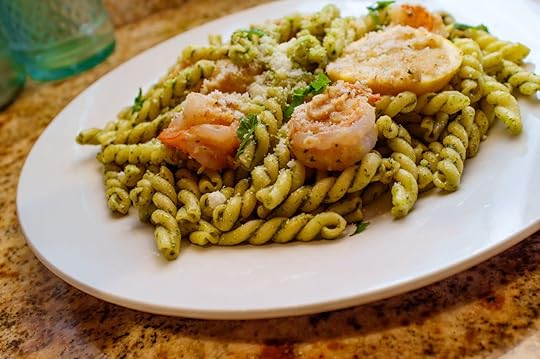
Photo: Ezume Images/Shutterstock
Gemelli means “twins” in Italian, though just one strand of pasta is used to make it. The s-shaped piece of pasta is twisted into a spiral or double helix shape.
29. Gramigna
Photo: Micaela Fiorellini/Shutterstock
This pasta style originated in Emilia Romagna. It’s named after a weed, which might explain the shape. The top half of a short, thin, hollow tube of pasta is curved into a circular spiral shape that resembles a piece of grass.
30. Grattoni
Photo: atm2003/Shutterstock
Grattoni is another small, round, grain-like shape of pasta served in soups. These diminutive varieties of pasta are known as pastina.
31. Lasagne
Photo: Todja/Shutterstock
The city of Naples gets the credit for coming up with lasagne. The name comes from the Greek word laganon, which was used to describe pasta dough that had been cut into strips. Traditionally, Parmigiano-Reggiano and a tomato-based pasta sauce are layered between sheets of lasagne (or lasagna) though many modern adaptations now include ricotta, ground beef, and spinach. A ribbon-style pasta called lasagnette is simply a narrower, longer version of lasagne.
32. Linguine
Photo: slow_food/Shutterstock
This long, thin, flat noodle originated in the Genoa and Liguria regions of Italy. Because it comes from the coast, linguine is often paired with seafood, particularly clams. The name means “little tongues.”
33. LorighittasThis Sardinian braided pasta was named for the iron rings used to hitch horses to houses and other buildings. Another story goes that the young women who made the pasta would hang it from their ears to dry, making the rings of pasta look like earrings. Lorighittas originated in the town of Morgongiori and are rare outside the town.
34. Lumache
Photo: GolubSergei/Shutterstock
This ridged, shell-shaped pasta is served with chunky sauce. The shape is very similar to that of a snail’s shell. Lumanche appears in both Roman and southern Italian cuisine. The larger version is known as lumaconi.
35. Mafaldine
Photo: sss615/Shutterstock
This curly pasta is said to have been named after the lustrous locks of a princess named Mafalda of Savoy. These long, flat noodles have ruffled edges that look similar to curly hair. Another name for this pasta is reginette, meaning little queen.
36. Maccheroni
Photo: Ezume Images/Shutterstock
Maccheroni is probably better known as macaroni — yes, of macaroni and cheese fame. Though maccheroni generally takes the form of a hollow tube, it can be formed into a variety of shapes, including short twists. The word maccheroni is probably derived from several Greek words, including makaria, meaning “food made from barley,” and makros, meaning “long.”
37. Maccheroncini di Campofilone
Photo: anna.q/Shutterstock
This silky noodle comes from the Le Marche region in central Italy. The long, thin noodles are similar to angel hair pasta and have a practical purpose, too. When the people of Le Marche first began making maccheroncini di Campofilone, they decided on thin strands to make it last longer, thus providing a source of food year-around.
38. Malloreddus
Photo: Alessio Orru/Shutterstock
These ridged shells are often called “little Sardinian gnocchi.” It’s so popular in Sardinia that it’s sometimes considered the island’s signature dish. Malloreddus is sometimes flavored using saffron, first introduced to the region by either the Moors or the Phoenicians.
39. Maltagliati
Photo: Irina Sokolovskaya/Shutterstock
Maltagliati literally means, “badly cut,” which might explain the uneven shape and thickness of these pasta squares from Emilia-Romagna. Originally, maltagliati was made using the scraps from tagliatelle dough.
40. Mezze maniche
Photo: francesco cepolina/Shutterstock
This short, hollow tube is of pasta from Emilia–Romagna means either “short sleeves” or “monk’s sleeves.” It’s about half the size of rigatoni, and ridges or grooves catch the sauce it’s served in.
41. Orecchiette
Photo: lovefranco/Shutterstock
Orecchiette, which means “little ears,” comes from Puglia, Italy, though a very similar version of this pasta also emerged in France in the Middle Ages. Orecchiette is shaped like a cup or a small bowl, which catches the sauce. One of the most popular ways to serve orecchiette is with broccoli rabe and sausage.
42. Orzo
Photo: RcriStudio/Shutterstock
Orzo might look like grains of rice or barley, but it’s actually a type of pasta. In Italian, orzo means barley, making matters a bit confusing. Though orzo did originate in Italy, it’s also very popular in Greece. Typically, it’s used in salads and soups and sometimes as a filling for peppers.
43. Paccheri
Photo: riccardo livorni/Shutterstock
Paccheri is (generally) a smooth tube of pasta from Campania that likely originated in Naples. Its shape is sometimes compared to pieces of cut up garden hose. One origin legend says that Sicilian pasta-makers created paccheri to smuggle banned garlic cloves into Austria (known as Prussia at the time) in the 1600s where imported garlic had been banned, as the garlic fit neatly in the hollowed out tube of pasta.
44. Pappardelle
Photo: Grifone97/Shutterstock
Pappardelle is a broad, long noodle from Tuscany, where it was originally prepared using chestnut flour. The name of this pasta might come from the Latin word pappare, meaning “to eat” or, more colloquially, “to gobble up.” It’s often served with hearty red sauce.
45. Penne
Photo: stockcreations/Shutterstock
Penne is another variety of pasta that’s popular in America. Penne means quill or feather, perhaps due to the slated ends of this ridged, tube-shaped pasta. A larger version is called pennoni or “giant pens.” Though penne originated in Liguria, one of the most beloved recipes for penne, called arrabbiata, comes from Rome. Arrabbiata, meaning “angry,” is a spicy red sauce made with tomatoes, chili peppers, and garlic.
46. Pincinelli
Photo: Vlasov Mikhail/Shutterstock
Pincinelli, also called bigoli or bigui, is very similar to spaghetti with one crucial difference: These long, super thin noodles are hollow with a hole at each end. Pincinelli likely originated in the Le Marche region of Italy.
47. Pizzoccheri
Photo: Francesco83/Shutterstock
This variation on a short tagliatelle is special in the pantheon of Italian pasta: The wide, flat noodles are made with buckwheat flour. Pizzoccheri probably originated in Lombardy, specifically in Valtellina, where it’s traditionally served in winter alongside potatoes and cabbage.
48. QuadrefioreQuadrefiore is supposedly shaped like a square flower with ruffled edges (or petals) on each side. Though Quadrefiore is hollow in the middle, it’s also quite dense and thick, so it requires a longer cooking time than most other pastas.
49. Quadretti
Photo: savitskaya iryna/Shutterstock
Quadretti, also known as quadrucci, are exactly what the name states: little squares. Though it’s found throughout Italy, the origin is probably Puglia or Abruzzo. Traditionally, quadretti is served in broth or soup.
50. Radiatore
Photo: ZB2/Shutterstock
The squat, square shape of radiatore is supposed to resemble a radiator. Given the ancient origin of most pasta, radiatore is actually a new addition. Some stories say that it was created between World War I and World War II while another legend speculates that it didn’t emerge until the 1960s, when the radiator grill on the Bugatti sports car inspired pasta-makers.
51. Ravioli
Photo: Abramova Elena/Shutterstock
The name for ravioli — a layer of filling (anything from ricotta to spinach) stuffed between two layers of pasta — comes from the word riavvolgere, which means “to wrap.” The exact origin of ravioli is difficult to pinpoint, though there is mention of it as far back as the 14th century in the city of Prato. Originally, ravioli was served in broth. It began appearing with tomato sauce around the 16th century.
52. RiccioliniRicciolini means “little curls.” Originating in Emilia-Romagna, in the city of Ferrara, ricciolini can be served with soup or sauce.
53. Rigatoni
Photo: Piyato/Shutterstock
The name for these short tubes of pasta comes from the word rigato, which means “ridged.” Rigatoni likely comes from central Italy, around Rome. Though rigatoni is generally bigger than penne (and doesn’t have the curved ends) it can be cut in a variety of diameters.
54. Rotelle
Photo: Dipali S/Shutterstock
Rotelle are pieces of pasta shaped like miniature wagon wheels, sometimes also called ruote.
55. SagnarelliSagnarelli comes from Abruzzo. This thick, short ribbon pasta has scalloped edges and is often served with cream sauce.
56. Spaghetti
Photo: Fusionstudio/Shutterstock
Spaghetti might be the most popular, and best known, style of pasta on this list, and it’s also one of the oldest. One cultural survey of Sicily from around 1154 mentions a precursor to spaghetti — dried strands of dough made from wheat flour — being exported to other regions of Italy. Another version called spaghetti alla chitarra originated in Abruzzo, where it was first made using a tool similar to a guitar (chitarra means guitar). The dough was placed on the chitarra then pushed through so that the strings cut the sheet of dough into strips.
57. Stortini
Photo: Sergej Cash/Shutterstock
This curved tube of pasta is similar to macaroni. However, stortini is much, much smaller (about the size of a fingernail). Given it’s small size, stortini is typically added to soups.
58. Strozzapreti
Photo: marandstock/Shutterstock
There are many legends surrounding the origins of strozzapreti. This “priest choking” pasta first appeared in Umbria, Tuscany, and Emilia-Romagna. One story goes that housewives, angry that they had to pay rent in part by cooking pasta for local priests, created a version that their unlucky guests could choke on. Another story goes that priests would often stop by the homes of locals for dinner but overstay their welcomes. In order to get the priests to stop dropping in for dinner, families would serve them strozzapreti as a warning. Or it could simply have picked up the name because the shape simply resembles a clerical collar.
59. Tagliatelle
Photo: ltummy/Shutterstock
These long, flat, and slightly narrow noodles come from Emilia-Romagna and Marche. According to legend, a chef in Bentivoglio invented tagliatelle in honor of Lucrezia Borgia in 1487. He cut the pasta into long strips to resemble her blonde hair. While that story might be romantic, it’s likely that tagliatelle is centuries older. One mention of a precursor to this ribbon pasta appears in a 1338 encyclopedia of foods from the Emilia-Romagna region. Tagliolini is tagliatelle’s distance cousin. It comes from the Liguria region of Italy, and it’s thinner than tagliatelle though still a long ribbon-style pasta, similar to spaghetti.
60. TorchioTorchio is the Italian word for a press (it can refer to either a wine or pasta press). However, the name for this pasta, which is found mostly in Emilia-Romagna, might actually be derived from torcia, or torch, to reflect its curved shape.
61. Trofiette
Photo: Yulia K/Shutterstock
The name for this Ligurian pasta might come from the word strufuggia, meaning ‘“to rub.” Originally, the pasta was prepared by rolling or rubbing pieces of pasta dough against a wooden board. Trofiette (sometimes also called trofie) comes from Recco in the Liguria region, the birthplace of focaccia.
62. Tortelli
Photo: ANTONIO TRUZZI/Shutterstock
This stuffed pasta comes in many shapes, including a twisted, circular shape, and a ravioli-like square. The filling depends on the region. In Tuscany, tortelli is often stuffed with spinach and ricotta or with tomatoes and garlic. In Emilia-Romagna it can be found stuffed with pumpkin or with ricotta and a butter sauce.
63. Tortellini
Photo: Fabio Balbi/Shutterstock
Tortellini is often described as navel-shaped and is a small pasta pouch with various fillings. One legend states that pasta makers in Modena were inspired by the belly button of the goddess Venus. Another story claims the impetus for creating tortellini was much more practical. It apparently originally emerged as a way to boil pasta with the fillings already inside.
64. TrenneThese pasta tubes have a triangular cut at each end and look similar to a quill or a fountain pen.
65. TrottoleTrottole comes from Campania. The name means “spinning top,” perfect for this squiggle-shaped noodle.
66. TufoliTufoli might look similar to penne, but there is a subtle difference. The tube is slightly curved, and it’s straight, not diagonally, cut at the end. There are many names for it, including occhi di elefante (elephants eyes) and occhi di bove (bull’s eye). It can also be stuffed with cheese or meat.
67. ZitiZiti probably originated in Naples, where a baked dish, still popular today, made with ziti was originally served at special occasions. Baked ziti is also a staple of celebratory Sunday lunches among big families. The longer version of ziti is called zitone. 
Matador Network's Blog
- Matador Network's profile
- 6 followers



